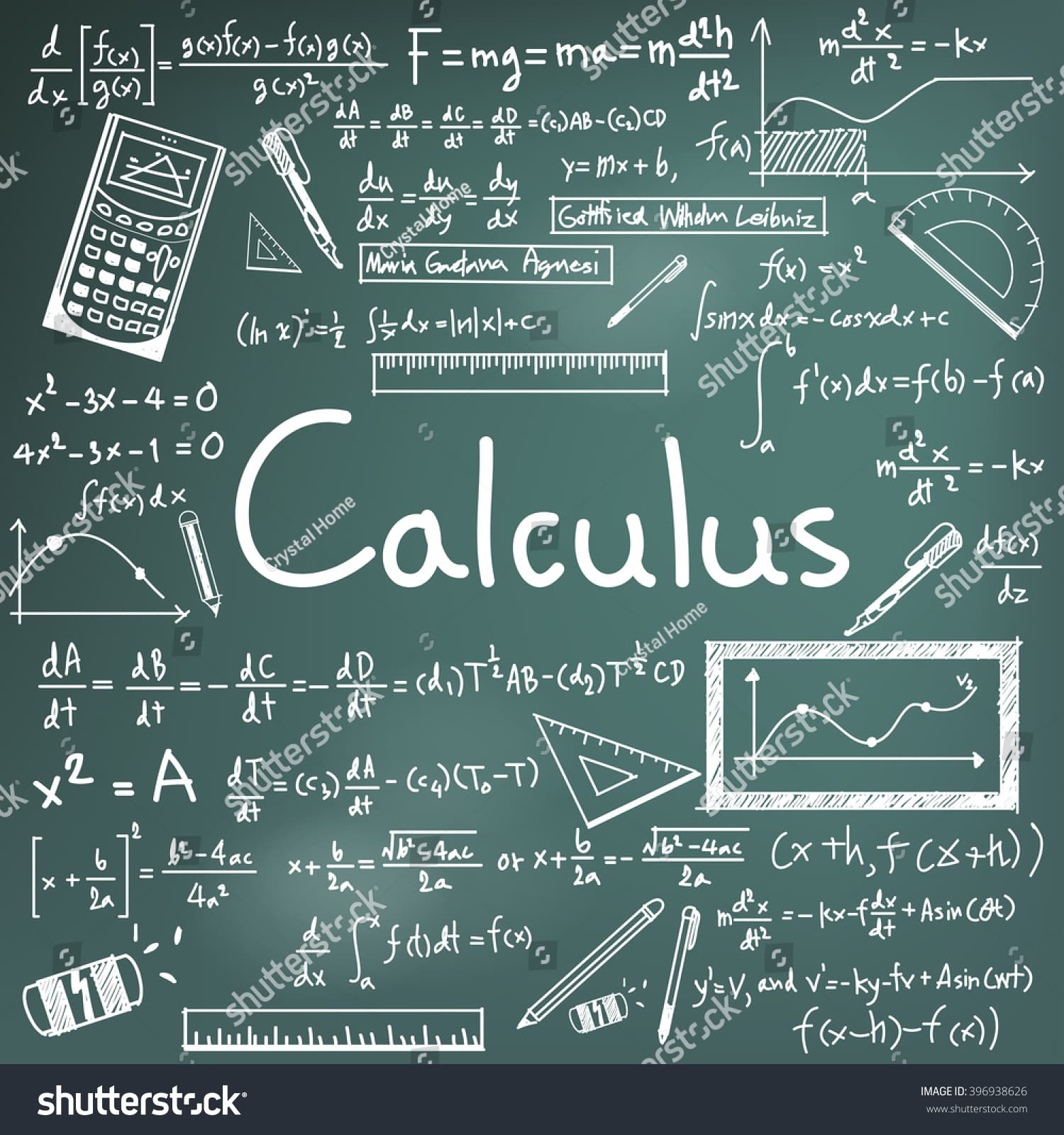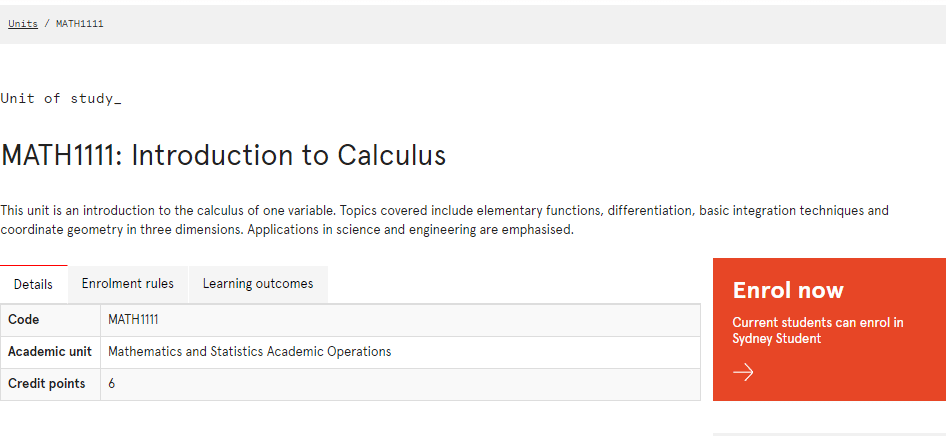MY-ASSIGNMENTEXPERT™可以为您提供sydney MATH1111 Calculus微积分的代写代考和辅导服务!
这是悉尼大学 微积分课程的代写成功案例。

MATH1111课程简介
This unit is an introduction to the calculus of one variable. Topics covered include elementary functions, differentiation, basic integration techniques and coordinate geometry in three dimensions. Applications in science and engineering are emphasised.
Prerequisites
At the completion of this unit, you should be able to:
- LO1. Apply mathematical logic and rigour to solving problems, and express mathematical ideas coherently in written and oral form;
- LO2. Demonstrate fluency in manipulating real numbers, their symbolic representations, operations, and solve associated algebraic equations and inequalities;
- LO3. Develop fluency with lines, coordinate geometry in two dimensions, the notion of a function, its natural domain, range and graph;
- LO4. Become conversant with elementary functions, including trigonometric, exponential, logarithmic and hyperbolic functions and be able to apply them to real phenomena and to yield solutions of associated equations;
- LO5. Perform operations on functions and be able to invert functions where appropriate;
- LO6. Understand the definitions of a derivative, definite and indefinite integral and be able to apply the definitions to elementary functions;
- LO7. Develop fluency in rules of differentiation, such as the product, quotient and chain rules, and use them to differentiate complicated functions;
- LO8. Understand and apply the Fundamental Theorem of Calculus; and develop fluency in techniques of integration, such as integration by substitution, the method of partial fractions and integration by parts;
- LO9. Develop some fluency with coordinate geometry in three dimensions, planes, surfaces, ellipsoids, paraboloids, level curves and qualitative features such as peaks, troughs and saddle points.
MATH1111 Calculus HELP(EXAM HELP, ONLINE TUTOR)
Find the area of the region enclosed by the graphs of $f(x)=3 x^2$ and $g(x)=x+2$.
The graph of the parabola $f(x)=3 x^2$ meets the graph of the line $g(x)=x+2$ when
$$
3 x^2=x+2 \quad \Longleftrightarrow \quad 3 x^2-x-2=0 \quad \Longleftrightarrow \quad(3 x+2)(x-1)=0 .
$$
Since the line lies above the parabola at the points $-2 / 3 \leq x \leq 1$, the area is then
$$
\int_{-2 / 3}^1[g(x)-f(x)] d x=\int_{-2 / 3}^1\left[x+2-3 x^2\right] d x=\left[\frac{x^2}{2}+2 x-x^3\right]_{-2 / 3}^1=\frac{125}{54} .
$$
Compute the volume of a sphere of radius $r>0$. Hint: one may obtain such a sphere by rotating the upper semicircle $f(x)=\sqrt{r^2-x^2}$ around the $x$-axis.
The volume of the sphere is the integral of $\pi f(x)^2$ and this is given by
$$
\int_{-r}^r \pi\left(r^2-x^2\right) d x=\pi\left[r^2 x-\frac{x^3}{3}\right]_{-r}^r=\pi\left(\frac{2 r^3}{3}+\frac{2 r^3}{3}\right)=\frac{4 \pi r^3}{3} .
$$
Compute the length of the graph of $f(x)=\frac{x^4}{16}+\frac{1}{2 x^2}$ over the interval $[1,3]$.
The length of the graph is given by the integral of $\sqrt{1+f^{\prime}(x)^2}$. In this case,
$$
f^{\prime}(x)=\frac{4 x^3}{16}-\frac{2}{2 x^3}=\frac{x^3}{4}-\frac{1}{x^3} \quad \Longrightarrow \quad f^{\prime}(x)^2=\frac{x^6}{16}+\frac{1}{x^6}-\frac{1}{2}
$$
so the expression $1+f^{\prime}(x)^2$ can be written in the form
$$
1+f^{\prime}(x)^2=\frac{x^6}{16}+\frac{1}{x^6}+\frac{1}{2}=\left(\frac{x^3}{4}+\frac{1}{x^3}\right)^2 .
$$
Taking the square root of both sides, we conclude that the length of the graph is
$$
\int_1^3 \sqrt{1+f^{\prime}(x)^2} d x=\int_1^3\left(\frac{x^3}{4}+\frac{1}{x^3}\right) d x=\left[\frac{x^4}{16}-\frac{1}{2 x^2}\right]_1^3=\frac{49}{9} .
$$
Find both the mass and the centre of mass for a thin rod whose density is given by
$$
\delta(x)=x^2+2 x+3, \quad 1 \leq x \leq 2 .
$$
The mass of the rod is merely the integral of its density function, namely
$$
M=\int_1^2 \delta(x) d x=\int_1^2\left(x^2+2 x+3\right) d x=\left[\frac{x^3}{3}+x^2+3 x\right]_1^2=\frac{25}{3} .
$$
The centre of mass is given by a similar formula and one finds that
$$
\bar{x}=\frac{1}{M} \int_1^2 x \delta(x) d x=\frac{3}{25} \int_1^2\left(x^3+2 x^2+3 x\right) d x=\frac{3}{25}\left[\frac{x^4}{4}+\frac{2 x^3}{3}+\frac{3 x^2}{2}\right]_1^2=\frac{31}{20} .
$$

MY-ASSIGNMENTEXPERT™可以为您提供sydney MATH1111 Calculus微积分的代写代考和辅导服务!



